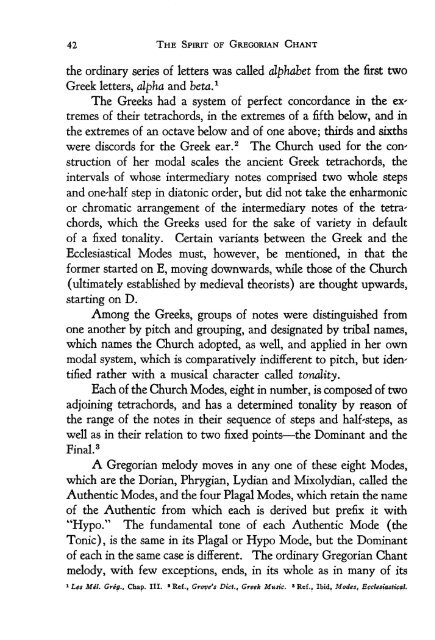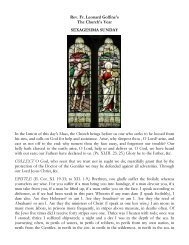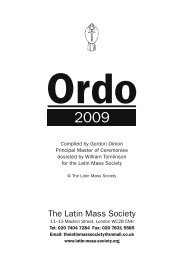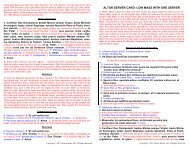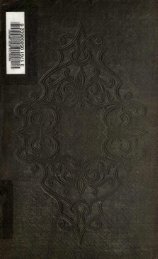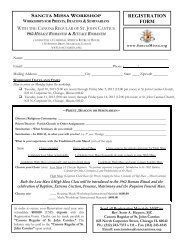The Spirit of Gregorian Chant - Church Music Association of America
The Spirit of Gregorian Chant - Church Music Association of America
The Spirit of Gregorian Chant - Church Music Association of America
Create successful ePaper yourself
Turn your PDF publications into a flip-book with our unique Google optimized e-Paper software.
42 THE SPIRIT OF GREGORIAN CHANT<br />
the ordinary series <strong>of</strong> letters was called alphabet from the first two<br />
Greek letters, alpha and beta. 1<br />
<strong>The</strong> Greeks had a system <strong>of</strong> perfect concordance in the extremes<br />
<strong>of</strong> their tetrachords, in the extremes <strong>of</strong> a fifth below, and in<br />
the extremes <strong>of</strong> an octave below and <strong>of</strong> one above; thirds and sixths<br />
were discords for the Greek ear. 2 <strong>The</strong> <strong>Church</strong> used for the con'<br />
struction <strong>of</strong> her modal scales the ancient Greek tetrachords, the<br />
intervals <strong>of</strong> whose intermediary notes comprised two whole steps<br />
and one-half step in diatonic order, but did not take the enharmonic<br />
or chromatic arrangement <strong>of</strong> the intermediary notes <strong>of</strong> the tetra'<br />
chords, which the Greeks used for the sake <strong>of</strong> variety in default<br />
<strong>of</strong> a fixed tonality. Certain variants between the Greek and the<br />
Ecclesiastical Modes must, however, be mentioned, in that the<br />
former started on E, moving downwards, while those <strong>of</strong> the <strong>Church</strong><br />
(ultimately established by medieval theorists) are thought upwards,<br />
starting on D.<br />
Among the Greeks, groups <strong>of</strong> notes were distinguished from<br />
one another by pitch and grouping, and designated by tribal names,<br />
which names the <strong>Church</strong> adopted, as well, and applied in her own<br />
modal system, which is comparatively indifferent to pitch, but iden'<br />
tified rather with a musical character called tonality.<br />
Each <strong>of</strong> the <strong>Church</strong> Modes, eight in number, is composed <strong>of</strong> two<br />
adjoining tetrachords, and has a determined tonality by reason <strong>of</strong><br />
the range <strong>of</strong> the notes in their sequence <strong>of</strong> steps and half'Steps, as<br />
well as in their relation to two fixed points—the Dominant and the<br />
Final. 3 A <strong>Gregorian</strong> melody moves in any one <strong>of</strong> these eight Modes,<br />
which are the Dorian, Phrygian, Lydian and Mixolydian, called the<br />
Authentic Modes, and the four Plagal Modes, which retain the name<br />
<strong>of</strong> the Authentic from which each is derived but prefix it with<br />
"Hypo." <strong>The</strong> fundamental tone <strong>of</strong> each Authentic Mode (the<br />
Tonic), is the same in its Plagal or Hypo Mode, but the Dominant<br />
<strong>of</strong> each in the same case is different. <strong>The</strong> ordinary <strong>Gregorian</strong> <strong>Chant</strong><br />
melody, with few exceptions, ends, in its whole as in many <strong>of</strong> its<br />
1 Les MSI. Grig., Chap. III. * Ref., Grove's Diet., Greek <strong>Music</strong>. *Ref., Ibid, Modes, Ecclesiastic?!.


